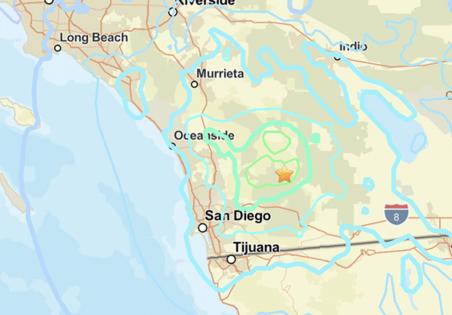'It shook everything': 5.2 magnitude earthquake hits San Diego County, felt across Southern California
Published in News & Features
LOS ANGELES — A magnitude 5.2 earthquake ruptured in San Diego County on Monday — jolting Southern California and providing a reminder of the power of the Elsinore fault, which is capable of spawning even more potent shaking across densely populated swaths of the region.
The epicenter of Monday’s earthquake, which hit at 10:08 a.m. Pacific time, was about 3 miles south of Julian, an old mining town in the Cuyamaca Mountains. There were no immediate reports of major damage or injuries, but some residents reported feeling a strong, frightening jolt.
The epicenter was about 3 miles southwest of one of the main mapped segments of the Elsinore fault, and roughly 40 miles northeast of downtown San Diego and 117 miles southeast of downtown Los Angeles.
The Elsinore fault is one to watch for Southern California. The California Geological Survey’s fault map shows the greater Elsinore fault zone stretching from the Mexican border through the Riverside County cities of Temecula, Murrieta and Lake Elsinore.
Around Corona, the Elsinore fault zone splits into two branches — the Chino fault, which stretches into Chino Hills, and the Whittier fault.
That second branch runs under the Puente Hills and is sandwiched between Hacienda Heights and Rowland Heights in the San Gabriel Valley to the north; and Yorba Linda, Brea, La Habra and Whittier to the south.
“The scary part about it is, if (an earthquake) started rupturing where this one did, and it ruptured to the north,” shaking energy would be directed into the Los Angeles area, said seismologist Lucy Jones, a Caltech research associate.
One particularly alarming scenario would be an earthquake that starts on the Elsinore fault and continues onto the Whittier fault, producing an earthquake greater than magnitude 7 that is “just going to pour all the energy straight into the L.A. Basin. It’s one of the scary earthquakes,” Jones said.
Such a quake could trigger worse shaking in Los Angeles than even the much-feared San Andreas fault, as the Elsinore fault is closer to the city.
The immediate repercussions of Monday’s temblor were relatively minor, owing to its epicenter being in a remote location, its modest magnitude, and its depth, some 8.9 miles underground.
The most intense shaking was considered somewhere between moderate to strong on the Modified Mercalli Intensity Scale — enough to break dishes and overturn unstable objects, and possibly to overturn heavy furniture. Shaking was considered “light” in downtown San Diego and “weak” in downtown L.A.
The shaking in Julian was strong enough to topple bottles at a liquor store, according to a video shared with KGTV-TV. Elsewhere in the community, wine glasses fell and shattered at a winery, and at a home in nearby Santa Ysabel, antique pottery fell from the shelves, the San Diego Union-Tribune reported.
In Palm Springs, people on social media shared footage from their security cameras showing significant shaking. At the San Diego Zoo Safari Park, elephants formed a circle around their young when the ground started shaking.
Shaking was felt for at least 30 seconds on the seventh floor of The Times’ newsroom in El Segundo, with an earthquake alert arriving just after the shaking started. In Manhattan Beach, a man heard rattling as he walked outside near two tall buildings.
Beatriz Scano was working at Soups & Such Cafe in Julian when she felt the earthquake, and immediately rushed to protect herself. Almost simultaneously, she said, phones started going off with the emergency alert.
“We could hear the phones going off while the earthquake was going,” Scano said. “It was pretty scary. It shook everything. Up here in Julian we have some every once in a while, but never that strong.”
The quake was the strongest she has felt in over a decade, she said, though it doesn’t compare to the magnitude 7.2 temblor she felt in Calexico in 2010, when she remembers a water tank bursting along with a bounce house that was set up for Easter celebrations. That earthquake killed four people and injured dozens more along the California-Mexico border.
Monday morning’s quake felt long, she said, estimating that with an aftershock it could have been shaking for about a minute.
“It was going and I was like, ‘OK, it’s going to stop,’ and then it kept going a little bit,” Scano said.
San Diego County firefighter Jarrett Ross, who was working at the agency’s Julian station Monday morning, said they all definitely felt the quake but said it was “nothing too crazy.”
He said the station hadn’t gotten any calls for injuries or damage since the earthquake.
“It was just a long one,” Ross said. He said nothing fell or became dislodged in the station due to the quake.
Mike Cornette, a fire captain with the California Department of Forestry and Fire Protection/San Diego County Fire, said no injuries or major damage were reported.
The California Department of Transportation warned drivers to watch out for rockslides, which have been documented on Highway 76.
Some people on social media told the U.S. Geological Survey that they got an earthquake early warning — fueled by the ShakeAlert system — on their cellphones.
“That was awesome! GREAT EARLY WARNING!!!” a resident told the USGS’ ShakeAlert social media account on X. “I got the alert on my phone near downtown San Diego several seconds before the primary (shaking) wave hit. WELL DONE!”
The Elsinore fault on average moves at a rate of about 5 millimeters a year, Jones said. It’s considered less likely to rupture in our lifetime compared to the San Andreas, which moves at around 20 millimeters a year. But it’s still more likely to rupture in our lifetime than the better-known Newport-Inglewood fault, which moves about 1 millimeter per year.
The Newport-Inglewood is more notorious in part because of its role in triggering the 1933 Long Beach earthquake, which caused 120 deaths and is the deadliest earthquake in Southern California’s modern history.
It has been 31 years since the magnitude 6.7 Northridge earthquake hit Los Angeles, and 35 years since the magnitude 6.9 Loma Prieta earthquake ruptured under Santa Cruz County, causing extensive damage across the San Francisco Bay Area.
But that quiet period won’t last forever. California’s largest earthquakes in modern times include a magnitude 7.9 earthquake in 1857, which ruptured about 185 miles of the San Andreas fault between Monterey County and Los Angeles County; and the great San Francisco earthquake of 1906, a magnitude 7.9 that destroyed much of the city and ruptured about 300 miles of the San Andreas fault between Mendocino and Santa Cruz counties.
_____
(Times staff writer Richard Winton contributed to this report.)
_____
©2025 Los Angeles Times. Visit at latimes.com. Distributed by Tribune Content Agency, LLC.







Comments